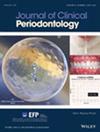Experimental Periodontitis Worsens Dopaminergic Neuronal Degeneration
Abstract
Aim
To investigate the hypothesis supporting the link between periodontitis and dopaminergic neuron degeneration.
Materials and Methods
Adult male Wistar rats were used to induce dopaminergic neuronal injury with 6-hydroxydopamine (6-OHDA) neurotoxin and experimental periodontitis via ligature placement. Motor function assessments were conducted before and after periodontitis induction in controls and 6-OHDA-injury-induced rats. Tissue samples from the striatum, jaw and blood were collected for molecular analyses, encompassing immunohistochemistry of tyrosine hydroxylase, microglia and astrocyte, as well as micro-computed tomography, to assess alveolar bone loss and for the analysis of striatal oxidative stress and plasma inflammatory markers.
Results
The results indicated motor impairment in 6-OHDA-injury-induced rats exacerbated by periodontitis, worsening dopaminergic striatal degeneration. Periodontitis alone or in combination with 6-OHDA-induced lesion was able to increase striatal microglia, while astrocytes were increased by the combination only. Periodontitis increased striatal reactive oxygen species levels and plasma tumour necrosis factor-alpha levels in rats with 6-OHDA-induced lesions and decreased the anti-inflammatory interleukin-10.
Conclusions
This study provides original insights into the association between periodontitis and a neurodegenerative condition. The increased inflammatory pathway associated with both 6-OHDA-induced dopaminergic neuron lesion and periodontal inflammatory processes corroborates that the periodontitis-induced systemic inflammation may aggravate neuroinflammation in Parkinson's-like disease, potentially hastening disease progression.

 求助内容:
求助内容: 应助结果提醒方式:
应助结果提醒方式:


